Yukon Gold (potato)
Yukon Gold is a large variety of potato most distinctly characterized by its thin, smooth eye free skin and yellow tinged flesh. This variety of potato was developed in the 1960s by G. R. Johnston, R.G. Rowberry, and Dr. Norman Thompson in Guelph, Ontario, Canada at the University of Guelph. The official cross was made in 1966 and the Yukon Gold was finally released into the market in 1980.
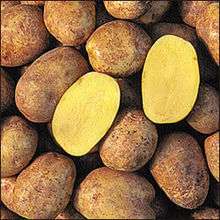
Cooking Methods
Unlike some other potato varieties the Yukon Gold can stand up to both dry heat and wet heat cooking methods. Its waxy moist flesh and sweet flavour make it ideal for boiling, baking and frying but these potatoes will also withstand grilling, pan frying, and roasting.
Variety Development
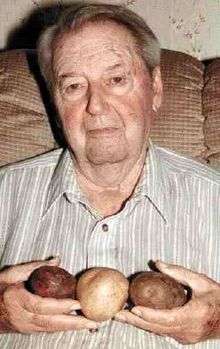
In the 1900s many Dutch and Belgian immigrants began settling in the “Banana Belt” region of southern Ontario. Many of these immigrants began vegetable farming around the towns of Simcoe, Leamington and Harrow along the shore of Lake Erie. In the 1950s the vegetable growers of this region began petitioning for the breeding rights and licensing for a yellow fleshed potato variety as they were used to growing in Europe. For Gary Johnston this began the nearly 30 year development of the Yukon Gold Potato.
In 1953, Johnston was one of the scientists that owned the potato development lab at the Ontario Agriculture College at the University of Guelph. In 1959 one of Johnston’s graduate students, a young man originally from Peru, told him of a small, rough, deep yellowed flesh potato that was grown by the indigenous communities in his home country. In Lima this potato variety is considered a delicacy due to its bright color and distinct flavor. After trying these Peruvian potatoes, Johnston started thinking about creating a variety that would have the same colour and flavor characteristics as these potatoes but would be larger in size and have a smoother shape similar to the potatoes being grown in the “Banana Belt”. In 1966 the development team made their first cross between a W5289-4 (2x cross between Yema de huevo and 2x Katahdin) and a Norgleam potato native to North Dakota. After the 66th cross that year, true seed was produced and the G6666 was created.
Variety Name
This variety of potato was named by Gary Johnston and Charlie Bishop. Initially named “Yukon” by Johnston for the Yukon River and gold rush country in Northern Canada, Bishop suggested adding Gold to better reflect the colour and appearance of the potato.
Agriculture and Growing

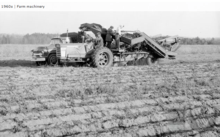
General Features
- Bred from Norgleam x W5279-4 cross at the University of Guelph, registered in 1980.
- Plant maturity reached at mid-season.
Botanical Features
- Leaves are olive green, moderately skinny and open away from stem.
- Flowers are light violet with a star of yellow-green at the base becoming light violet towards the edges.
- Buds range from light green to purplish green.
- Tubers (Potatoes) are oval with a slightly flattened shape and with smooth contours and shallow eyes.
- Skin appears light yellow to light golden brown and is flaked with yellow.
- Flesh is yellow in colour and has high moisture content.
- Sprouts are reddish purple.
Nutritional facts
For 1 medium potato - 150g
- Calories 110
- Total Fat 0 g
- Saturated 0 g
- Polyunsaturated 0 g
- Monounsaturated 0 g
- Trans 0 g
- Sodium 10 mg
- Potassium 770 mg
- Total Carbs 26 g 9%*
- Dietary Fiber 2 g 8%*
- Sugars 3 g
- Protein 3 g
- Cholesterol 0 mg
- Vitamin A 0%*
- Vitamin C 50%*
- Calcium 2%*
- Iron 15%*
- Percent Daily Values are based on a 2,000 calorie diet. Your daily values may be higher or lower depending on your calorie needs.
 Leaf
Leaf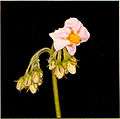 Flower
Flower Plant
Plant Sprout
Sprout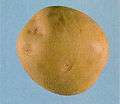 Skin
Skin Flesh
Flesh
Agricultural Features
- Medium to high yield.
- Large tubers are slightly susceptible to hollow heart (hollowed center of potato)
- Excellent storability due to long dormancy phase; best to store in a cold dark place.
Disease Reactions[1]
Very susceptible to, seed decay, blackleg, early blight, late blight, early dying, PVY, soft rot, dry rot, leak, pink rot, silver scurf and black scurf.
Susceptible to, common scab.
Moderately tolerant to, leaf roll.
Tolerant to, PVX.
Storage
This variety is resistant to bruising and does not sprout a lot due to the fact that it has good dormancy. If they are stored correctly they will not lose a lot of moisture compared to other varieties. It is important that the lenticels are not swollen and that the skin is not bruised because this can lead to major rot issues.[1]
See also
| Wikimedia Commons has media related to Solanum tuberosum 'Yukon Gold'. |
External links
- 1 2 Network, University of Nebraska-Lincoln | Web Developer. "YUKON GOLD: MANAGEMENT PROFILE | CropWatch". cropwatch.unl.edu. Retrieved 2016-12-02.
- Yukon Gold Characteristics
- Yukon Gold Information Page
- Yukon Gold Potato Research Program History
- Kerry's Island Kitchen
- Canadian Food Inspection Agency: Yukon Gold